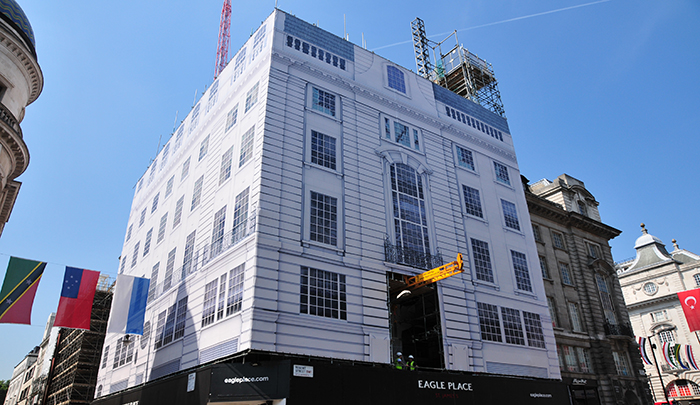Building wraps
Building wraps are large-scale printed sheet materials that can be fixed to scaffolding structures and used to conceal building work. They are commonly digitally printed with a CGI rendering or photographic image of the building façade, attempting in some way to ‘blend in’ better with its context than traditional debris netting would.
It is a technique that is sometimes used on important buildings, or in sensitive locations, to hide unsightly scaffolding while providing a tantalising representation of what the building looks, or will look, like.
The benefits of building wraps are that they can help to reduce the spread of dust and other debris, conceal construction work from the public, and mean that views of the under-construction building is minimised.
The scaffolding must be securely erected for the building wrap to be installed. If necessary, engineers must calculate wind loading to be ensure that the installation of the wrap will not be a hazard to the scaffolding.
Building wraps are typically installed onto a 'picture frame' scaffold structure which projects about 300 mm further out than the last projected pole on the main scaffolding. Any projecting scaffold poles should be capped to cover sharp ends. This allows the wrap banner to move with the wind without getting caught on any poles which can cause damage.
Two commonly used fixing methods are standard and invisible:
- The standard method involves a picture frame that is made up of perimeter scaffolding with the wrap banner sitting about 150 mm inside the frame, fixed using 12 mm bungee cable (so the scaffold is visible).
- The invisible method is more difficult but is generally thought to give a better appearance. The wrap banner is pulled completely smooth, placed over the outside of the picture frame scaffolding and clamped using clamp couplers/joins.
Typically, the scaffolding picture frame is installed before printing the wrap, so that an accurately measured template can be provided to the designers. This ensures that the wrap covers the scaffold completely, that it is taut enough and does not crease.
Building wraps can serve as a form of discreet advertising, in the same way as hoardings. However, they may require planning permission from the local authority.
[edit] Related articles on Designing Buildings Wiki
- Architectural photography.
- Architectural reprography.
- Computer-generated imagery (CGI).
- Debris netting.
- Hoarding.
- Perimeter security.
- Rubble chute.
- Scaffolding.
[edit] External references
- Building wrap specialist: Project Print Management
Featured articles and news
Latest Build UK Building Safety Regime explainer published
Key elements in one short, now updated document.
UKGBC launch the UK Climate Resilience Roadmap
First guidance of its kind on direct climate impacts for the built environment and how it can adapt.
CLC Health, Safety and Wellbeing Strategy 2025
Launched by the Minister for Industry to look at fatalities on site, improving mental health and other issues.
One of the most impressive Victorian architects. Book review.
Common Assessment Standard now with building safety
New CAS update now includes mandatory building safety questions.
RTPI leader to become new CIOB Chief Executive Officer
Dr Victoria Hills MRTPI, FICE to take over after Caroline Gumble’s departure.
Social and affordable housing, a long term plan for delivery
The “Delivering a Decade of Renewal for Social and Affordable Housing” strategy sets out future path.
A change to adoptive architecture
Effects of global weather warming on architectural detailing, material choice and human interaction.
The proposed publicly owned and backed subsidiary of Homes England, to facilitate new homes.
How big is the problem and what can we do to mitigate the effects?
Overheating guidance and tools for building designers
A number of cool guides to help with the heat.
The UK's Modern Industrial Strategy: A 10 year plan
Previous consultation criticism, current key elements and general support with some persisting reservations.
Building Safety Regulator reforms
New roles, new staff and a new fast track service pave the way for a single construction regulator.
Architectural Technologist CPDs and Communications
CIAT CPD… and how you can do it!
Cooling centres and cool spaces
Managing extreme heat in cities by directing the public to places for heat stress relief and water sources.
Winter gardens: A brief history and warm variations
Extending the season with glass in different forms and terms.
Restoring Great Yarmouth's Winter Gardens
Transforming one of the least sustainable constructions imaginable.























